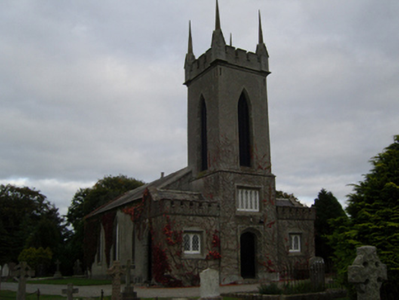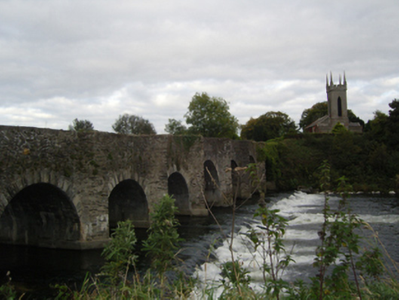Survey Data
Reg No
15701510
Rating
Regional
Categories of Special Interest
Architectural, Artistic, Historical, Social, Technical
Original Use
Church/chapel
In Use As
Church/chapel
Date
1830 - 1835
Coordinates
296860, 148824
Date Recorded
08/10/2007
Date Updated
--/--/--
Description
Detached three-bay double-height single-cell Board of First Fruits Church of Ireland church, built 1834, on a rectangular plan with single-bay single-storey vestries centred on single-bay three-stage tower to entrance (west) front on a square plan. Pitched slate roof with lichen-covered clay ridge tiles, cut-granite coping to gables, and cast-iron rainwater goods on rendered slate flagged eaves retaining cast-iron octagonal or ogee hoppers and downpipes. Part creeper- or ivy-covered roughcast walls on rendered chamfered plinth; creeper- or ivy-covered roughcast surface finish to tower with cut-granite stringcourses including cut-granite "Cavetto" stringcourse (bell stage) supporting obelisk-topped pinnacles centred on battlemented parapets having cut-granite "saddleback" coping. Lancet window openings with carved timber Y-mullions, and cut-granite surrounds having chamfered reveals framing one-over-one timber sash windows having cast-iron lattice glazing bars. Pointed-arch window opening to chancel (east) with interlocking timber Y-mullions, and cut-granite surround having chamfered reveals framing one-over-one timber sash windows having cast-iron lattice glazing bars. Tudor-headed door opening to tower with cut-granite step threshold, and cut-granite surround having chamfered reveals framing timber boarded or tongue-and-groove timber panelled double doors having overpanel. Square-headed window opening (second stage) with carved timber mullions, and cut-granite surround having chamfered reveals framing fixed-pane fittings having cast-iron lattice glazing bars. Lancet openings (bell stage) with cut-granite "slated" sill course, and cut-granite surrounds having chamfered reveals framing applied timber Y-mullions over louvered timber fittings. Interior including vestibule (west); full-height interior open into roof with carpeted central aisle between timber panelled box pews, cut-white marble Classical-style wall monuments (ob. 1836; 1971), Gothic-style timber panelled pulpit on an octagonal plan with Gothic-style timber clerk's desk, stepped dais to chancel (east) with wrought iron-detailed barley twist balusters supporting carved timber communion railing centred on altar (1924) below "East Window", and exposed trefoil-arcaded tie beam timber roof construction with wind braced rafters to timber boarded ceiling on carved timber cornice. Set in landscaped grounds on a corner site with piers to perimeter having cut-granite shallow pyramidal capping supporting wrought iron double gates.
Appraisal
A church erected with financial support from the Board of First Fruits (fl. 1711-1833) representing integral component of the early nineteenth-century built heritage of County Wexford with the architectural value of the composition, one recalling the near-contemporary Saint John's Church (Clonmore), Ballybuckley (see 15702571), confirmed by such attributes as the standardised nave-with-entrance tower plan form, aligned along a liturgically-correct axis; the slender profile of the openings underpinning a later English Georgian Gothic theme with the chancel defined by an elegant "East Window"; and the elongated pinnacles embellishing the gently tapering tower as a picturesque eye-catcher in the landscape. Having been well maintained, the elementary form and massing survive intact together with substantial quantities of the original fabric, both to the exterior and to the interior where contemporary joinery; and restrained wall monuments, all highlight the artistic potential of the composition: meanwhile, an exposed timber roof construction pinpoints the engineering or technical dexterity of a church making a pleasing visual statement overlooking the River Slaney.





















